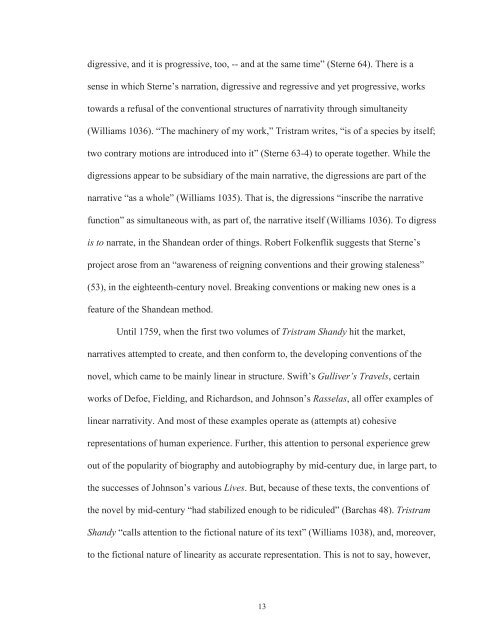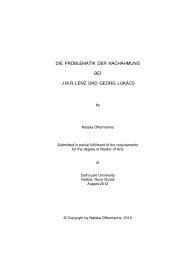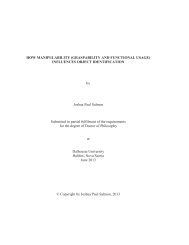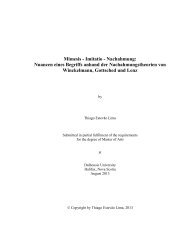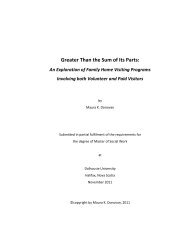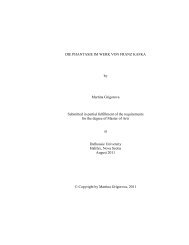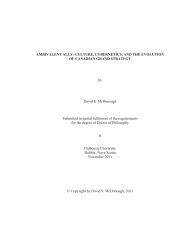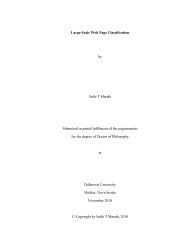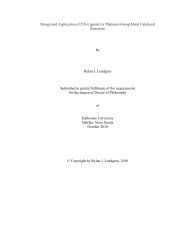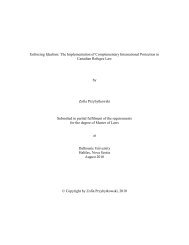ADAPTING TRISTRAM SHANDY by Adria Young Submitted in ...
ADAPTING TRISTRAM SHANDY by Adria Young Submitted in ...
ADAPTING TRISTRAM SHANDY by Adria Young Submitted in ...
Create successful ePaper yourself
Turn your PDF publications into a flip-book with our unique Google optimized e-Paper software.
digressive, and it is progressive, too, -- and at the same time” (Sterne 64). There is a<br />
sense <strong>in</strong> which Sterne’s narration, digressive and regressive and yet progressive, works<br />
towards a refusal of the conventional structures of narrativity through simultaneity<br />
(Williams 1036). “The mach<strong>in</strong>ery of my work,” Tristram writes, “is of a species <strong>by</strong> itself;<br />
two contrary motions are <strong>in</strong>troduced <strong>in</strong>to it” (Sterne 63-4) to operate together. While the<br />
digressions appear to be subsidiary of the ma<strong>in</strong> narrative, the digressions are part of the<br />
narrative “as a whole” (Williams 1035). That is, the digressions “<strong>in</strong>scribe the narrative<br />
function” as simultaneous with, as part of, the narrative itself (Williams 1036). To digress<br />
is to narrate, <strong>in</strong> the Shandean order of th<strong>in</strong>gs. Robert Folkenflik suggests that Sterne’s<br />
project arose from an “awareness of reign<strong>in</strong>g conventions and their grow<strong>in</strong>g staleness”<br />
(53), <strong>in</strong> the eighteenth-century novel. Break<strong>in</strong>g conventions or mak<strong>in</strong>g new ones is a<br />
feature of the Shandean method.<br />
Until 1759, when the first two volumes of Tristram Shandy hit the market,<br />
narratives attempted to create, and then conform to, the develop<strong>in</strong>g conventions of the<br />
novel, which came to be ma<strong>in</strong>ly l<strong>in</strong>ear <strong>in</strong> structure. Swift’s Gulliver’s Travels, certa<strong>in</strong><br />
works of Defoe, Field<strong>in</strong>g, and Richardson, and Johnson’s Rasselas, all offer examples of<br />
l<strong>in</strong>ear narrativity. And most of these examples operate as (attempts at) cohesive<br />
representations of human experience. Further, this attention to personal experience grew<br />
out of the popularity of biography and autobiography <strong>by</strong> mid-century due, <strong>in</strong> large part, to<br />
the successes of Johnson’s various Lives. But, because of these texts, the conventions of<br />
the novel <strong>by</strong> mid-century “had stabilized enough to be ridiculed” (Barchas 48). Tristram<br />
Shandy “calls attention to the fictional nature of its text” (Williams 1038), and, moreover,<br />
to the fictional nature of l<strong>in</strong>earity as accurate representation. This is not to say, however,<br />
13


